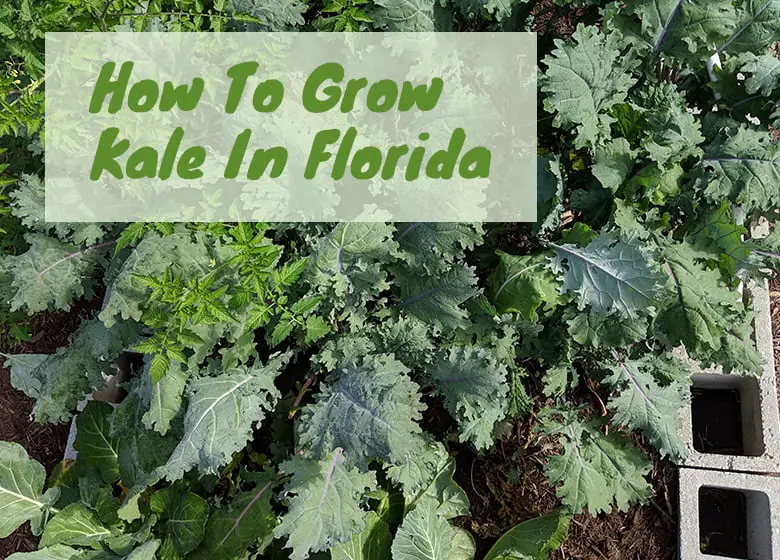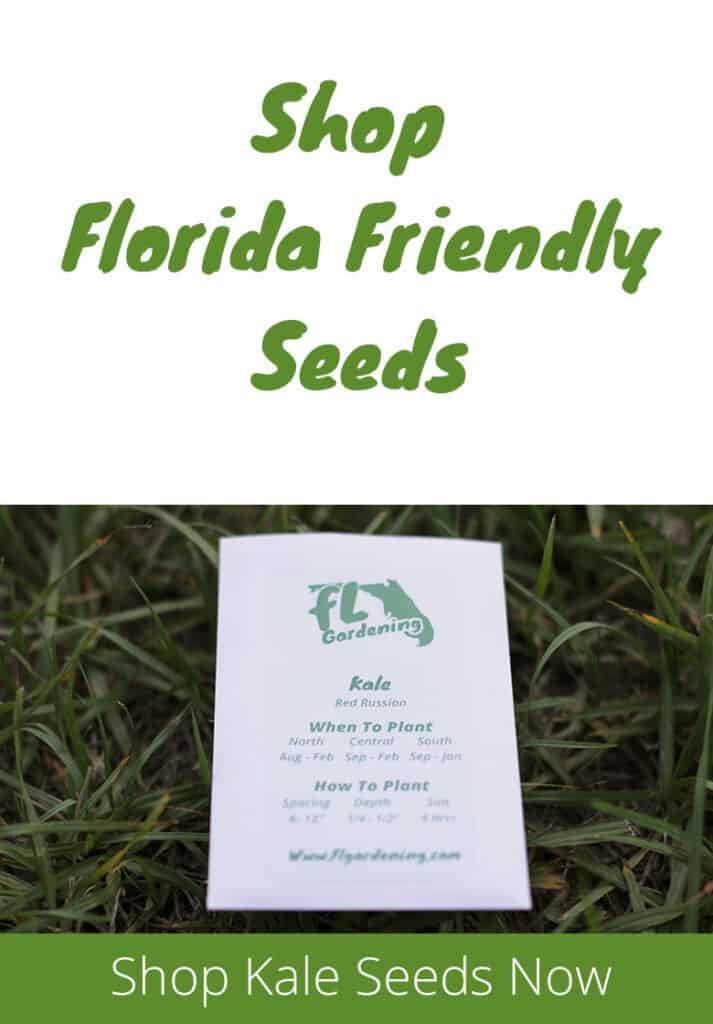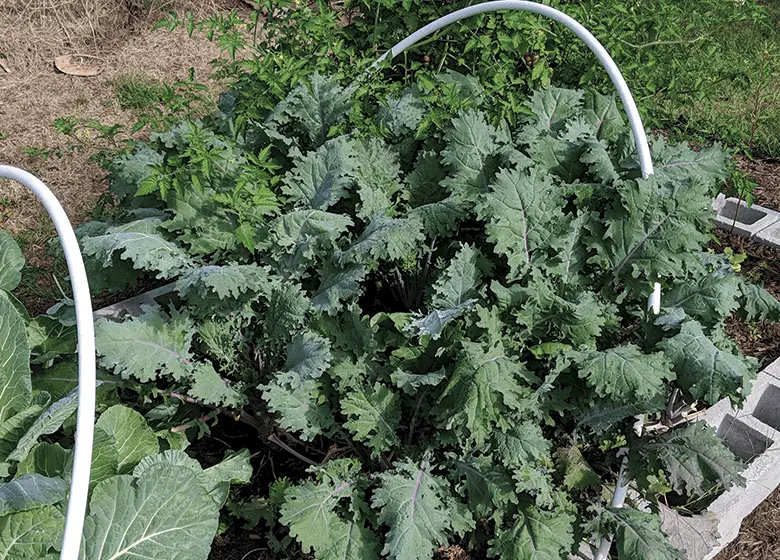
I was buying so much kale at the grocery store I thought to myself, “damn, I should buy stock in this stuff.” So then my next, more logical thought was, is growing kale In Florida easy?
Can you grow kale in Florida? Yes, plant Florida friendly varieties of kale like Lacinato, Tuscan, Red Russian, Blue Curled Vates, and Winterbor in the fall and winter months.
Growing kale in Florida is actually pretty easy. The above-mentioned varieties are all edible, Florida can actually grow ornamental kale as well and it looks super cool.
Different Varieties of Kale That Grow In Florida

Florida can grow edible kale as well as inedible, ornamental varieties. I’ve only ever grown the edible variety but I’ve seen some of the ornamental kinds at nurseries around me and they look really cool. They are full of texture and eye catching colors.
Edible Varieties
Tuscan/Lacinato- Often refereed to as one in the same, Lacinato or Tuscan kale has a very wrinkly texture. The leaves are skinny and the plant can grown between 2-3 feet tall.
Red Russian- This kale has purple veins and leaves that are much larger and a less bumpy texture than the Tuscan/Lacinato variety. This is the kind of kale that I have grown most in my garden. It’s leaves have a nice green blue color to them.
Blue Curled Vates– This is a dwarf variety of kale. This kale will usually only grow about a foot and a half tall. This is a curly kale, it has leaf edges that are full of frills. Blue curled vates is cold resistant so it can easily be grown in the north Florida winters.
Winterbor– This is an another type of kale that can withstand the coldest nights the Florida has to throw at it. This kale can grow up to 2 feet tall and has lots of green ruffly leaves.
Ornamental Kale
Ornamental kale is not edible but it looks super attractive in the garden. Decorative kale will usually brighten up in color when the nights are colder. According to the University of Florida, ornamental Kale requires nights that are 40°F to color-up.
Pigeon Purple– grows more wide than tall, it has multiple layers of greenish-blue leaves with a deep purpler center.
Glamour Red– The center of this kale is a vibrant pinkish-red. It’s leaves are more curly than the pigeon purple kale and also more waxy.
I’ve never tried to grow kale for decoration but I might soon try too because I’ve had such good luck with growing it as an edible food and I’m getting increasingly more interested in decorative landscaping.
When To Plant Kale In Florida
When kale gets exposed to higher heat and longer days it’s response will be to bolt. This means it will send out flowers and start the process of making new baby kales. When the plant focuses its energy on flowering instead of leafy growth your harvests are done. The leaves also start to taste bitter.
Kale takes about 50-60 days to be ready to harvest so we need to get the seeds in the ground to give the plant enough time to grow before it starts to get too hot.
In all parts of Florida you can directly plant kale seed in the ground during the fall and winter months, that’s September through March. This is Robert Bowden’s advice from his book Florida fruit and vegetable gardening. The university of Florida has slightly different planting recommendations. They say to plant no later than February and that north Florida can begin planting in August.
I’m in central Florida and have not had a problem growing kale that I’ve planted between these recommended times.
Best Soil For Kale
Kale is not that picky of a plant. If you wanted to you could definitly add some compost and peat moss to your Florida soil with a thick layer of mulch and be able to grow kale.
However, for something to really thrive it takes years of building your soil up. but if you are planting in a raised bed or a container then I think you should make your own soil. I’ve always had really good look with this mix:
- 40% Peat moss (Check price on Amazon)
- 40% Compost (You can get it on Amazon but I’ve found it way cheaper at local stores)
- 20% perlite (Check price on Amazon)
- Worm castings (Check price on Amazon)
- Mykos (Check price on Amazon)
This mix gives you loads of organic material, lots of things for the roots to grab onto, good airflow and drainage, as well as plenty of nutrients.
Where To Plant Kale
Kale needs at least 6 hours of sun to be able to grow decently. If your kale is grown in the shade you will have weak looking spindly plants. They are reaching for more sun but don’t have enough energy to grow because of their lack of sun.

Also think about placement in your garden. As the kale ages it will begin to cast shade as well. If grown next to shorter plants, like a black seeded Simpson lettuce, it may block lots more sun than you think. I made the mistake of planting my lettuce directly to the east of my kale. As the kale matured it began to block out lots more sun than I had anticipated. So keep the kale’s surroundings in mind when planning where to plant kale.
How To Plant Kale
Kale can be grown by directly sowing the seeds into the garden or you can stick home grown or store bought transplants right into the dirt. The variety of kale that you are growing will effect how manty kale plants you can fit into a certian space.
I have the most experience with Red Russian kale. This plant can grow about 2-3 feet tall and maybe about a foot wide or so. The dwarf variety, Blue Curled kale will only grow to about 15″ tall and be much more compact. So keep these things in mind when planting your kale.
I’ve had the best luck with planting kale directly into the garden. I always think dealing with transplants is kind of a pain. When I plant my seeds I throw a lot down. I use the spray and pray approach. I sprinkle way more seeds than i think that I would need.
Lots of kale will pop up and it will certainly be over crowded. As the seedlings pop up I begin to snip the weak ones . I only keep ones that I think are in good position and look the strongest. I find this planting method beneficial because you are playing the odds game and it’s in your favor this way.
If the plants aren’t exactly 18″ apart I’ve found that to be ok. One plant will grow larger than the other next to it. The space will be filled, and you’ll be able to harvest from both.
How To Harvest Kale
Kale takes about 50-60 days to be ready for harvest. You will be able to harvest kale for a while after this though. You can continue harvesting kale all the way up until it begins to bolt.
The best leaves to harvest are the lowest leaves of the plant. Harvesting the newest growth will damage the plant and you will get a small harvest. The lower leaves are larger and tastier. Depending on the variety of kale the leaf sizes will change, but generally when leaves are about 10 inches long they are ready for harvest.
Take a pair of shears and snip off the lowest leaves of the plant. If you wait too long to harvest the leaves will thicken up and not be as tasty. They will be a little more bitter and harder to eat.
How To Fertilize Kale
Kale does not produce a fruit so it’s fertilizing needs are different than a plant that does make fruit, like a tomato. Each nutrient does something different for the plant.
The three numbers that you see on many fertilizer bags are the N-P-K values. N is nitrogen, p is phosphorous and K is potassium. The plant uses nitrgoen for green leafy growth. Phosphorous is used for flowering and fruiting and potassium is used as an overall health booster.
So the best fertilizer for kale is one that is nitrogen focused. I like to use a fish fertilizer(Check price on amazon). it’s a 5-1-1, so it’s heavily nitrogen focused and that helps the kale plant grow, healthy and abundant green leaves.
It’s a liquid fertilizer that I mix together in a spray bottle with water and once a week I spray this mix on my plants and water with it as well.
Common Pest And Diseases That Attack Kale In Florida
I think the most common pests you will find in Florida that attack your Kale are:
- Aphids
- Caterpillars
- Whiteflies
These pests are commonly found on leafy growth.
Aphids are little soft bodied greenish- yellow bugs that congregate on the underside of leaves. They have stupid pointy mouths that pierce your plant and suck it’s juices out.
There are lots of different caterpillars that may attack your plant. Things like the cabbage lopper, or hornworm will all damage your plant in the same way. They simply munch on the leaves like you would.
Whiteflies are small soft-bodied bugs that lay eggs on the underside of your leaves. they damage your plant after their eggs hatch and their larvae feed on the juices of your plant. The leaves will begin to have a splotchy yellow appearance on the top side.
The most common diseases that Kale is effected by are:
- Alternaria Leaf Spot
- Downy Mildew
- Black Rot
These are not specific to kale but to all leafy green growing plants in Florida. Alternia Leaf Spot will look black/brown circular spots all over the leaves. Downy Mildew will show up as yellow spots on the tops of leaves and a little fuzzy layer underneath the leaves. Black Rot is pretty much how it sounds, The plants look like they are rotting and turn black
Can Kale Be Grown In Containers?
Yes, kale is easily grown in containers. You can fit multiple kale plants in a single pot . Kale plants can grow both wide and deep. So make sure that your pot is deep enough. I would recommend a pot that is at least 22 inches wide and 2 feet deep. A pot this size can fit at least three kale plants. Maybe more of the dwarf Curled Blue kale variety.
You Might Also Like: How To Grow Collard Greens In Florida

